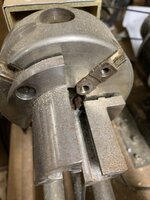you could certainly try!
I started off with a lot less tools than most people do because I had a bit of know-how around the shop. You really don't need specialized stuff, you just need to be picky about your technique if you want things to be straight. I made quite a few crooked pens at first!
As others said - you'll need drill bits. Figure out the pilot holes you need for the holes you have to tap and make sure you have them. For metric taps the thread size is the diameter minus the pitch - for M12x0.8 that's 11.2, for M14x0.8 that's 13.2mm. Anything that gets you to that dimension or about 0.15mm larger is fine (11.2-11.35, 13.2-13.35 - for M13 for example I bore with a 31/64" bit). For a section you can get an M10x1 tap and die set off amazon to start. Victor is good for bits, McMaster Carr too. You'll also need taps for the section you want to put in the pen - for the M14 it's probably a Jowo #6, which requires a 7.5x0.5mm tap. You'll need an I, N and R bit to drill out the section, and an L bit for the back side to give the converter room to wiggle.
For mandrels - Delrin/Acetal, off amazon. I think my first mandrels were 5/8" delrin. Turns easily on a wood lathe.
For a die holder, use the appropriate sized forstner bit if you have one, in a block of hard wood. use wood that leaves you about 1/4" on the top and bottom around the die. drill and tap for the divots on the die and pin the die in place with whatever screws you can tap for - for me it was pan-head wood screws. now you've got a die holder! to use it, you put open up your tailstock-mounted jacobs chuck (leave the tailstock unlocked) and put the back of the die holder against the face of the chuck. this ensures it's perpendicular to the work. rotate the headstock and keep it pressed against the tenon, and you'll be cutting threads! i put a through-hole in the wood so that I could thread my first mandrels with it. for threading the mandrel i just took the jacobs out and extended the tailstock quill. the face of the quill keeps the die perpendicular enough.
for a tap holder, just chuck your M12, M14, and M10 in the jacobs. this is how I still tap everything except for sections. my section tap is bent, so I use it in a
general brand tap wrench with a
spring-loaded tap follower. this lets the tap keep itself centered in its pilot hole. I like this kind of tap wrench because it doesn't require the tap to have a divot - none of my jowo/bock taps have divots so i can't use them in the really cheap tap wrenches.
and i think that's about it. you can upgrade to sliding die and tap holders as you grow your craft, but starting out it's not necessary. I would strongly recommend the PSI or Beall collet chuck with a collet set but it's not critical... but what it will give you that a jawed chuck won't is concentricity, and while you're learning that's one of the most important variables to eliminate... you want your parts to be held true no matter which way you flip them, so that any screwups can be identified as the simple things to address (better technique) rather than potentially shoddy work-holding.
if you aren't considering it, strongly consider attending the MPG virtual symposium. it was
@mark james kitless tutorial that started me down the rabbit hole in 2021!

